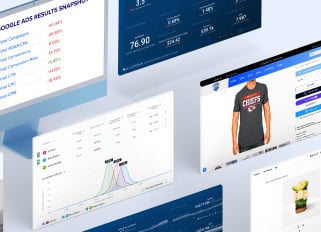
Link Building for Shopify: A Simple Guide for Beginners
Do you know that more than 4.6 million online stores rely on Shopify? With Shopify, businesses can set up an online shop quickly and easily with a user-friendly platform and customizable templates. The main benefits that have helped Shopify rise to the top include seamless integration with various payment gateways, robust security features, effective inventory management, and access to insightful analytics - all of which are essential for efficiently managing and scaling an e-commerce business.
Just look at this data: 175 countries worldwide reach, $901 million gross profit in the third quarter of 2023 (up 36% year-over-year), and 11,600 staff. It’s hard to deny Shopify’s powerful presence. The platform provides excellent opportunities for businesses in the field of e-commerce. Therefore, the competition is high, and many owners face a real challenge - how to promote their website. So, how can you get organic traffic, bring new customers, and increase brand awareness all at the same time? We got you. Today, we’re here to talk about link-building for Shopify.
What is Link-Building?
Link-building is about obtaining essential hyperlinks from other websites to yours. Search engines like Google use them as one of the key ranking factors. In other words, each link to your website is viewed as a vote of confidence, indicating your content is valuable and credible. By utilizing link-building strategies for your Shopify store, you can benefit your business substantially through:
- Increased visibility.
- More organic traffic.
- More interested visitors.
- Valuable insights into customer behaviors.
Unlike paid advertising, which stops driving traffic once you stop paying, the benefits of link-building can continue long after the initial effort. With quality, backlinks you can expect ongoing referral traffic and sustained visibility.
One example of a perfect image of using link-building for Shopify is Fashion Nova, a US-based fashion retail company known for its trendy, affordable clothing and accessories. For every new collection launch or collaboration, Fashion Nova uses press releases that fashion news outlets and blogs pick up, often linking back to their Shopify store. On top of that, Fashion Nova is also known for collaborating with influencers and celebrities. These personalities feature Fashion Nova's clothing on social media platforms and personal blogs, additionally providing valuable backlinks to the store's website.
How Many Backlinks Do You Need?
We want to get the record straight from the start-quantity-based efforts are a lost cause. However, determining the exact number of backlinks needed for a Shopify store can be complicated as it depends on various factors unique to each store. These factors include:
- The store's industry;
- The competitiveness of its niche;
- The quality of the backlinks;
- The overall SEO strategy.
For a promoted website, it's recommended to aim for around 40 to 50 backlinks directed to the homepage and 0-100 backlinks for each separate webpage. The competitiveness in SEO terms starts to kick in with these figures. The impact of backlinks varies greatly. Links from sites with higher authority are significantly more influential. Of course, the more backlinks, the better. But keep in mind that quality should be over quantity.
How to Build Links to Your Shopify Store
As a result, the question arises: how exactly can you get backlinks to your Shopify store? First and foremost, we don't recommend you act off the cuff. Building links is a strategic process that should be well thought out. What we do recommend instead is a simple list we’ve created below that will allow you to play your cards right.
- Create compelling, informative, and relevant content.
- Collaborate with influencers in your niche.
- Contribute articles to popular blogs or websites related to your niche.
- Share your content, products, and blog posts on social media platforms.
- Engage in relevant online forums and communities.
- - Design and publish infographics related to your niche.
- Encourage satisfied customers to review your products on their blogs or websites.
- Team up with complementary brands for joint promotions or campaigns.
Building links to a Shopify store involves content creation, influencer collaborations, guest blogging, social media engagement, community participation, restoring broken links, and encouraging product reviews, among other things. Most important of all, though, is a strong link-building strategy that can effectively drive backlinks and enhance your store's SEO. In this next section, we’ll explore them in depth.
Competitor Analysis
Competitor analysis is a case where your competitors can actually help your business and is a powerful strategy for building links for your Shopify store. This strategy involves examining your competitors' backlink profiles to understand where they are acquiring their links and identifying opportunities for your own store.
First, determine who your direct competitors are. Once that’s figured out, you can then use SEO tools to analyze their backlinks.
One of our favorite tools is Ahrefs Site Explorer. This service breaks down the types of backlinks (such as dofollow, nofollow, redirect, etc.) and provides metrics on the quality of these links. With Ahrefs Site Explorer, you can assess which high-authority sites link to your competitors, offering valuable targets for your link-building outreach.
From this conducted analysis, you can then identify websites or platforms where your competitors are getting links and where you might be lacking. After determining solid websites to link to, you can then strategically create content that can organically note backlinks from these targeted sites. Don’t forget to monitor the effectiveness of your link-building efforts and adapt your strategy as needed.
Business Directories
This strategy involves listing your store in relevant online directories. It offers backlinks from credible sources. For instance, a Shopify store specializing in handmade crafts could list itself in directories like Etsy, Craftsy, and local business directories. These listings provide quality backlinks and expose the store to a broader audience actively seeking niche products.
Guest Posting
Through the trials and errors of trying to build our own backlinks- we’ve discovered that this strategy has proven to be the most effective for promoting Shopify stores. Simply put, guest posting is when you publish articles on other websites or blogs in your niche. This method involves creating valuable content that these platforms' audiences will find interesting. In return, you get a backlink to your Shopify store within the content or in an author bio.
For example, if you run a Shopify store selling fitness equipment, you could guest post on fitness and wellness blogs, offering insights on workout routines or equipment maintenance. This effortlessly drives traffic back to your store and establishes your brand as an authority in the fitness domain. This approach not only enhances your store's SEO but also broadens its reach and draws a targeted audience.
Where can you look for blogs and websites to post content with backlinks?
For starters, you can find many free guest posting sites without having to pay for publishing your articles. If you use a content marketing marketplace like Collaborator, this can be a breeze. With Collaborator, you can select from 25 436 platforms available, each passing strict moderation before being added to the catalog. If you fear that there are too many sites to sift through, worry that there is an advanced filter where you can fine-tune your options. When you’ve found the perfect site, all you need to do is reach out to the owners or administrators with materials to publish- all for next to nothing.
Broken Link Building
Implementing the broken link-building strategy starts with exploring the internet for external websites with broken links, particularly those relevant to the store's industry. Once these defunct links are found, the next step is to create content for the Shopify store's blog similar to what was initially linked. Reach out to the owners of these external sites, informing them of the broken links and suggesting your newly created content as a replacement.
Hello [Name],
I stumbled upon your recent post about [Topic] and noticed that the linked page is no longer accessible.
I'm not sure if you're revisiting and updating your older posts. Still, if you are, I wanted to share that my guide outlines a comparable process with added details on how to accurately estimate the value of your assets and debts. This additional information is crucial for a precise net worth calculation.
I've attached a screenshot highlighting where I found the link on your page.
Feel free to take a look whenever you have the time
Talk soon,
[Name]
For instance, if a home decor blogger mistakenly links to an extinct page about vintage lamp restoration, a Shopify store selling DIY restoration kits could publish a detailed guide on this subject. The store would then propose this guide to the blogger, replacing the broken link with their own.
Skyscraper Link Building
In a nutshell, you should always be aiming to create content that surpasses existing content on a particular topic in terms of quality, depth, or value. The technique is based on the philosophy of improving upon what is already popular and widely linked to your niche. So, how exactly is this implemented?
- Start by researching and identifying popular content.
- Then, create more comprehensive material.
- After, reach out to websites linked to the original page.
- Then, suggest replacing or supplementing the existing links with a link to your website.
Imagine you own a Shopify store specializing in gourmet coffee beans. How can you implement the Skyscraper technique? Identify a widely shared blog post from a well-known coffee blog and then create a more detailed guide. Once you do that, reach out to websites that link to the original blog post and offer your comprehensive guide as a more in-depth resource for their readers.
Resource Pages
Resources pages are all about leveraging pages on other websites that list helpful links and resources for their audience. The goal is to feature your Shopify store or specific products on these pages. For instance, if your store sells artisanal coffee, you should seek out resource pages that list quality suppliers or coffee-related educational content. In a nutshell, reach out to the owners and highlight the relevance and value of your store or products. By simply getting featured on these resource pages, you can bet on authoritative backlinks to your shop.
Unlinked Mentions
Imagine groups of people mentioning your brand's name in their articles, yet with no backlink attached. To try to scope out these unlinked mentions, use Google Alerts. Once you find these unlinked mentions, you can reach out to the website owners or authors, thanking them for the mention and politely requesting to turn it into a hyperlink that directs to your store.
Testimonials
Collect positive testimonials from satisfied customers who have purchased from your Shopify store and display them prominently on your website. To expand on this strategy, you can also ask customers to share these reviews and further link your store.
Join Communities
By joining relevant communities and participating in them actively, you can show yourself as an expert in your field and bring backlinks to your website. You can start by:
- Finding online forums, social media groups, and communities related to your store's niche.
- Engaging actively in discussions, offering insights, advice, and solutions.
- Sharing blog posts, guides, and other content.
- Forming connections with other community members, influencers, and industry experts.
- Offering helpful responses to queries.
- Including a link to your Shopify store in your forum signature.
- Offering special discounts or exclusive products to community members.
Let's say you sell baking supplies and tools via your Shopify store. To implement a community-based link-building strategy, you should identify and join various online platforms where your target audience is likely to engage, such as BakeSpace, Reddit Baking community, Food Blogger Pro, or even groups from Pinterest, Facebook, LinkedIn, or Slack dedicated to baking, pastry arts, and home cooking.
Final Thoughts
All in all, link-building is crucial to enhancing your online store's visibility and credibility. For beginners, the journey starts with understanding the basics: quality over quantity and relevance over randomness. We are talking about a continuous process that requires consistency, patience, and a focus on building genuine relationships. We recommend starting small, being open to learning, and gradually expanding your strategies as you go.
Moreover, we advise you to adhere to ethical SEO practices. This means avoiding shortcuts and focusing on strategies that provide value to both your audience and the websites you engage with. By implementing the right link-building approach, you can significantly contribute to the success of your Shopify store. Good luck!
Connect With Us
Recent Post

.png)





Tell us what you think!